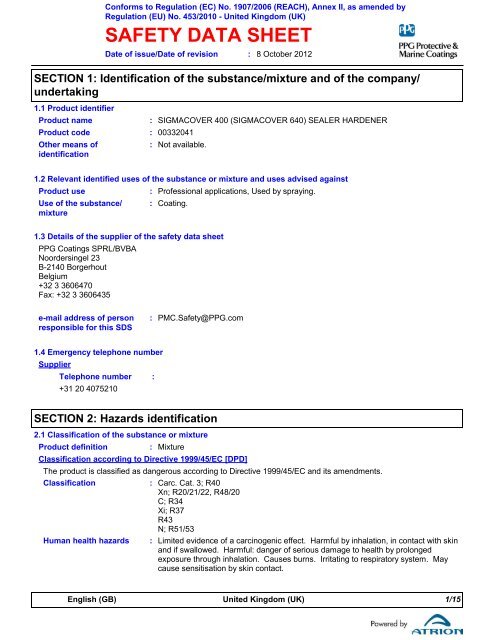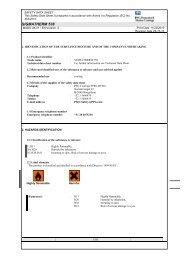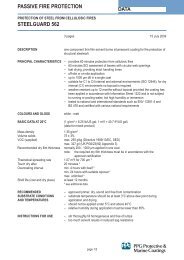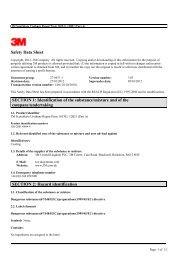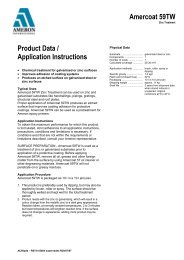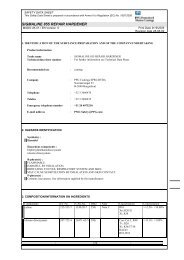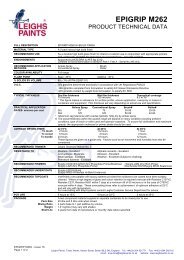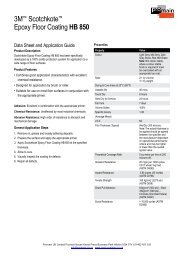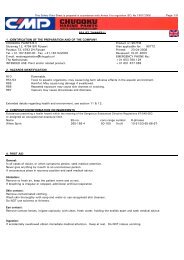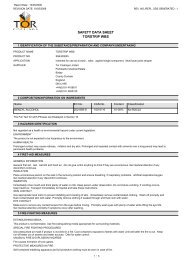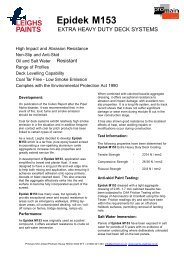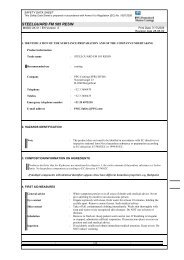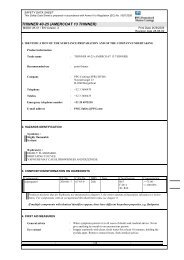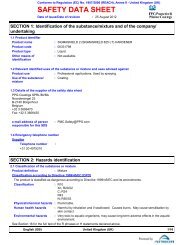SigmaCover 400 Sealer Hardener Safety Data Sheet - Promain
SigmaCover 400 Sealer Hardener Safety Data Sheet - Promain
SigmaCover 400 Sealer Hardener Safety Data Sheet - Promain
You also want an ePaper? Increase the reach of your titles
YUMPU automatically turns print PDFs into web optimized ePapers that Google loves.
1.1 Product identifier<br />
Product name<br />
Other means of<br />
identification<br />
Conforms to Regulation (EC) No. 1907/2006 (REACH), Annex II, as amended by<br />
Regulation (EU) No. 453/2010 - United Kingdom (UK)<br />
SAFETY DATA SHEET<br />
Date of issue/Date of revision : 8 October 2012<br />
SECTION 1: Identification of the substance/mixture and of the company/<br />
undertaking<br />
Product code : 00332041<br />
:<br />
:<br />
SIGMACOVER <strong>400</strong> (SIGMACOVER 640) SEALER HARDENER<br />
Not available.<br />
1.2 Relevant identified uses of the substance or mixture and uses advised against<br />
Product use<br />
Use of the substance/<br />
mixture<br />
: Professional applications, Used by spraying.<br />
: Coating.<br />
1.3 Details of the supplier of the safety data sheet<br />
PPG Coatings SPRL/BVBA<br />
Noordersingel 23<br />
B-2140 Borgerhout<br />
Belgium<br />
+32 3 3606470<br />
Fax: +32 3 3606435<br />
e-mail address of person<br />
responsible for this SDS<br />
: PMC.<strong>Safety</strong>@PPG.com<br />
1.4 Emergency telephone number<br />
Supplier<br />
Telephone number :<br />
+31 20 4075210<br />
SECTION 2: Hazards identification<br />
2.1 Classification of the substance or mixture<br />
Product definition<br />
Classification<br />
Human health hazards<br />
: Mixture<br />
Classification according to Directive 1999/45/EC [DPD]<br />
The product is classified as dangerous according to Directive 1999/45/EC and its amendments.<br />
:<br />
:<br />
Carc. Cat. 3; R40<br />
Xn; R20/21/22, R48/20<br />
C; R34<br />
Xi; R37<br />
R43<br />
N; R51/53<br />
Limited evidence of a carcinogenic effect. Harmful by inhalation, in contact with skin<br />
and if swallowed. Harmful: danger of serious damage to health by prolonged<br />
exposure through inhalation. Causes burns. Irritating to respiratory system. May<br />
cause sensitisation by skin contact.<br />
English (GB)<br />
United Kingdom (UK)<br />
1/15
Conforms to Regulation (EC) No. 1907/2006 (REACH), Annex II - United Kingdom (UK)<br />
Code : 00332041 Date of issue/Date of revision : 8 October 2012<br />
SIGMACOVER <strong>400</strong> (SIGMACOVER 640) SEALER HARDENER<br />
SECTION 2: Hazards identification<br />
Environmental hazards : Toxic to aquatic organisms, may cause long-term adverse effects in the aquatic<br />
environment.<br />
See Section 16 for the full text of the R phrases or H statements declared above.<br />
See Section 11 for more detailed information on health effects and symptoms.<br />
2.2 Label elements<br />
Hazard symbol or symbols :<br />
Indication of danger :<br />
Risk phrases<br />
<strong>Safety</strong> phrases<br />
Hazardous ingredients<br />
Supplemental label<br />
elements<br />
Special packaging requirements<br />
Containers to be fitted<br />
with child-resistant<br />
fastenings<br />
Tactile warning of danger<br />
:<br />
:<br />
: furfuryl alcohol<br />
Poly[oxy(methyl-1,2-ethanediyl)], α-(2-aminomethylethyl)-ω-(2-aminomethylethoxy)-<br />
3,6-diazaoctanethylenediamin<br />
: Not applicable.<br />
:<br />
:<br />
Corrosive, Dangerous for the environment<br />
R40- Limited evidence of a carcinogenic effect.<br />
R20/21/22- Harmful by inhalation, in contact with skin and if swallowed.<br />
R48/20- Harmful: danger of serious damage to health by prolonged exposure<br />
through inhalation.<br />
R34- Causes burns.<br />
R37- Irritating to respiratory system.<br />
R43- May cause sensitisation by skin contact.<br />
R51/53- Toxic to aquatic organisms, may cause long-term adverse effects in the<br />
aquatic environment.<br />
S23- Do not breathe vapour or spray.<br />
S26- In case of contact with eyes, rinse immediately with plenty of water and seek<br />
medical advice.<br />
S36/37/39- Wear suitable protective clothing, gloves and eye/face protection.<br />
S38- In case of insufficient ventilation, wear suitable respiratory equipment.<br />
S45- In case of accident or if you feel unwell, seek medical advice immediately<br />
(show the label where possible).<br />
S61- Avoid release to the environment. Refer to special instructions/safety data<br />
sheet.<br />
Not applicable.<br />
Not applicable.<br />
2.3 Other hazards<br />
Other hazards which do<br />
not result in classification<br />
:<br />
None known.<br />
English (GB)<br />
United Kingdom (UK)<br />
2/15
Conforms to Regulation (EC) No. 1907/2006 (REACH), Annex II - United Kingdom (UK)<br />
Code : 00332041 Date of issue/Date of revision : 8 October 2012<br />
SIGMACOVER <strong>400</strong> (SIGMACOVER 640) SEALER HARDENER<br />
SECTION 3: Composition/information on ingredients<br />
Substance/mixture<br />
Product/ingredient<br />
name<br />
:<br />
Mixture<br />
Identifiers<br />
furfuryl alcohol EC: 202-626-1<br />
CAS: 98-00-0<br />
Index: 603-018-00-2<br />
Poly[oxy(methyl-1,2-<br />
ethanediyl)], α-(2-<br />
aminomethylethyl)-ω-(2<br />
-aminomethylethoxy)-<br />
Formaldehyde,<br />
polymer with 1,<br />
3-dimethylbenzene<br />
20 -<br />
Conforms to Regulation (EC) No. 1907/2006 (REACH), Annex II - United Kingdom (UK)<br />
Code : 00332041 Date of issue/Date of revision : 8 October 2012<br />
SIGMACOVER <strong>400</strong> (SIGMACOVER 640) SEALER HARDENER<br />
SECTION 3: Composition/information on ingredients<br />
[1] Substance classified with a health or environmental hazard<br />
[2] Substance with a workplace exposure limit<br />
[3] Substance meets the criteria for PBT according to Regulation (EC) No. 1907/2006, Annex XIII<br />
[4] Substance meets the criteria for vPvB according to Regulation (EC) No. 1907/2006, Annex XIII<br />
Occupational exposure limits, if available, are listed in Section 8.<br />
SUB codes represent substances without registered CAS Numbers.<br />
SECTION 4: First aid measures<br />
4.1 Description of first aid measures<br />
Eye contact<br />
Inhalation<br />
Skin contact<br />
Ingestion<br />
Protection of first-aiders<br />
:<br />
:<br />
:<br />
:<br />
Check for and remove any contact lenses. Immediately flush eyes with running<br />
water for at least 15 minutes, keeping eyelids open. Seek immediate medical<br />
attention.<br />
Remove to fresh air. Keep person warm and at rest. If not breathing, if breathing is<br />
irregular or if respiratory arrest occurs, provide artificial respiration or oxygen by<br />
trained personnel.<br />
Remove contaminated clothing and shoes. Wash skin thoroughly with soap and<br />
water or use recognised skin cleanser. Do NOT use solvents or thinners.<br />
If swallowed, seek medical advice immediately and show the container or label.<br />
Keep person warm and at rest. Do NOT induce vomiting.<br />
: No action shall be taken involving any personal risk or without suitable training. If it<br />
is suspected that fumes are still present, the rescuer should wear an appropriate<br />
mask or self-contained breathing apparatus. It may be dangerous to the person<br />
providing aid to give mouth-to-mouth resuscitation. Wash contaminated clothing<br />
thoroughly with water before removing it, or wear gloves.<br />
4.2 Most important symptoms and effects, both acute and delayed<br />
Potential acute health effects<br />
Eye contact<br />
Inhalation<br />
Skin contact<br />
Ingestion<br />
Over-exposure signs/symptoms<br />
Eye contact<br />
Inhalation<br />
Skin contact<br />
Ingestion<br />
:<br />
: Harmful by inhalation. Irritating to respiratory system. Exposure to decomposition<br />
products may cause a health hazard. Serious effects may be delayed following<br />
exposure.<br />
: Corrosive to the skin. Causes burns. Harmful in contact with skin. May cause<br />
sensitisation by skin contact.<br />
:<br />
Corrosive to eyes. Causes burns.<br />
Harmful if swallowed. May cause burns to mouth, throat and stomach.<br />
: Adverse symptoms may include the following:<br />
pain<br />
watering<br />
redness<br />
: Adverse symptoms may include the following:<br />
respiratory tract irritation<br />
coughing<br />
:<br />
:<br />
Adverse symptoms may include the following:<br />
pain or irritation<br />
redness<br />
blistering may occur<br />
Adverse symptoms may include the following:<br />
stomach pains<br />
English (GB)<br />
United Kingdom (UK)<br />
4/15
Conforms to Regulation (EC) No. 1907/2006 (REACH), Annex II - United Kingdom (UK)<br />
Code : 00332041 Date of issue/Date of revision : 8 October 2012<br />
SIGMACOVER <strong>400</strong> (SIGMACOVER 640) SEALER HARDENER<br />
SECTION 4: First aid measures<br />
4.3 Indication of any immediate medical attention and special treatment needed<br />
Notes to physician<br />
Specific treatments<br />
:<br />
:<br />
In case of inhalation of decomposition products in a fire, symptoms may be delayed.<br />
The exposed person may need to be kept under medical surveillance for 48 hours.<br />
No specific treatment.<br />
SECTION 5: Firefighting measures<br />
5.1 Extinguishing media<br />
Suitable extinguishing<br />
media<br />
Unsuitable extinguishing<br />
media<br />
:<br />
:<br />
Use an extinguishing agent suitable for the surrounding fire.<br />
None known.<br />
5.2 Special hazards arising from the substance or mixture<br />
Hazards from the<br />
substance or mixture<br />
Hazardous combustion<br />
products<br />
:<br />
:<br />
In a fire or if heated, a pressure increase will occur and the container may burst.<br />
Decomposition products may include the following materials:<br />
carbon dioxide<br />
carbon monoxide<br />
nitrogen oxides<br />
5.3 Advice for firefighters<br />
Special precautions for<br />
fire-fighters<br />
Special protective<br />
equipment for fire-fighters<br />
SECTION 6: Accidental release measures<br />
:<br />
:<br />
Promptly isolate the scene by removing all persons from the vicinity of the incident if<br />
there is a fire. No action shall be taken involving any personal risk or without<br />
suitable training. This material is toxic to aquatic organisms. Fire water<br />
contaminated with this material must be contained and prevented from being<br />
discharged to any waterway, sewer or drain.<br />
Fire-fighters should wear appropriate protective equipment and self-contained<br />
breathing apparatus (SCBA) with a full face-piece operated in positive pressure<br />
mode. Clothing for fire-fighters (including helmets, protective boots and gloves)<br />
conforming to European standard EN 469 will provide a basic level of protection for<br />
chemical incidents.<br />
6.1 Personal precautions, protective equipment and emergency procedures<br />
For non-emergency<br />
personnel<br />
For emergency responders :<br />
:<br />
No action shall be taken involving any personal risk or without suitable training.<br />
Evacuate surrounding areas. Keep unnecessary and unprotected personnel from<br />
entering. Do not touch or walk through spilt material. Do not breathe vapour or mist.<br />
Provide adequate ventilation. Wear appropriate respirator when ventilation is<br />
inadequate. Put on appropriate personal protective equipment.<br />
If specialised clothing is required to deal with the spillage, take note of any<br />
information in Section 8 on suitable and unsuitable materials. See also Section 8 for<br />
additional information on hygiene measures.<br />
6.2 Environmental<br />
precautions<br />
:<br />
Avoid dispersal of spilt material and runoff and contact with soil, waterways, drains<br />
and sewers. Inform the relevant authorities if the product has caused environmental<br />
pollution (sewers, waterways, soil or air). Water polluting material. May be harmful<br />
to the environment if released in large quantities.<br />
6.3 Methods and materials for containment and cleaning up<br />
English (GB)<br />
United Kingdom (UK)<br />
5/15
Conforms to Regulation (EC) No. 1907/2006 (REACH), Annex II - United Kingdom (UK)<br />
Code : 00332041 Date of issue/Date of revision : 8 October 2012<br />
SIGMACOVER <strong>400</strong> (SIGMACOVER 640) SEALER HARDENER<br />
SECTION 6: Accidental release measures<br />
Small spill :<br />
Large spill :<br />
Stop leak if without risk. Move containers from spill area. Dilute with water and mop<br />
up if water-soluble. Alternatively, or if water-insoluble, absorb with an inert dry<br />
material and place in an appropriate waste disposal container. Dispose of via a<br />
licensed waste disposal contractor.<br />
Stop leak if without risk. Move containers from spill area. Approach the release<br />
from upwind. Prevent entry into sewers, water courses, basements or confined<br />
areas. Wash spillages into an effluent treatment plant or proceed as follows.<br />
Contain and collect spillage with non-combustible, absorbent material e.g. sand,<br />
earth, vermiculite or diatomaceous earth and place in container for disposal<br />
according to local regulations. Dispose of via a licensed waste disposal contractor.<br />
Contaminated absorbent material may pose the same hazard as the spilt product.<br />
6.4 Reference to other<br />
sections<br />
SECTION 7: Handling and storage<br />
:<br />
See Section 1 for emergency contact information.<br />
See Section 8 for information on appropriate personal protective equipment.<br />
See Section 13 for additional waste treatment information.<br />
The information in this section contains generic advice and guidance. The list of Identified Uses in Section 1 should be<br />
consulted for any available use-specific information provided in the Exposure Scenario(s).<br />
7.1 Precautions for safe handling<br />
Protective measures :<br />
Advice on general<br />
occupational hygiene<br />
:<br />
Put on appropriate personal protective equipment (see Section 8). Eating, drinking<br />
and smoking should be prohibited in areas where this material is handled, stored<br />
and processed. Workers should wash hands and face before eating, drinking and<br />
smoking. Remove contaminated clothing and protective equipment before entering<br />
eating areas. Persons with a history of skin sensitization problems should not be<br />
employed in any process in which this product is used. Do not get in eyes or on skin<br />
or clothing. Do not breathe vapour or mist. Do not ingest. Avoid release to the<br />
environment. Refer to special instructions/safety data sheet. Use only with<br />
adequate ventilation. Wear appropriate respirator when ventilation is inadequate.<br />
Keep in the original container or an approved alternative made from a compatible<br />
material, kept tightly closed when not in use. Empty containers retain product<br />
residue and can be hazardous. Do not reuse container.<br />
Eating, drinking and smoking should be prohibited in areas where this material is<br />
handled, stored and processed. Workers should wash hands and face before<br />
eating, drinking and smoking. Remove contaminated clothing and protective<br />
equipment before entering eating areas. See also Section 8 for additional<br />
information on hygiene measures.<br />
7.2 Conditions for safe<br />
storage, including any<br />
incompatibilities<br />
:<br />
Storage temperature: 0 to 35°C (32 to 95°F). Store in accordance with local<br />
regulations. Store in original container protected from direct sunlight in a dry, cool<br />
and well-ventilated area, away from incompatible materials (see Section 10) and<br />
food and drink. Keep container tightly closed and sealed until ready for use.<br />
Containers that have been opened must be carefully resealed and kept upright to<br />
prevent leakage. Do not store in unlabelled containers. Use appropriate<br />
containment to avoid environmental contamination.<br />
7.3 Specific end use(s)<br />
Recommendations :<br />
Industrial sector specific<br />
solutions<br />
:<br />
Not available.<br />
Not available.<br />
English (GB)<br />
United Kingdom (UK)<br />
6/15
Conforms to Regulation (EC) No. 1907/2006 (REACH), Annex II - United Kingdom (UK)<br />
Code : 00332041 Date of issue/Date of revision : 8 October 2012<br />
SIGMACOVER <strong>400</strong> (SIGMACOVER 640) SEALER HARDENER<br />
SECTION 8: Exposure controls/personal protection<br />
The information in this section contains generic advice and guidance. The list of Identified Uses in Section 1 should be<br />
consulted for any available use-specific information provided in the Exposure Scenario(s).<br />
8.1 Control parameters<br />
Occupational exposure limits<br />
No exposure limit value known.<br />
Recommended monitoring<br />
procedures<br />
DNELs<br />
DNELs - Not available.<br />
PNECs<br />
PNECs - Not available.<br />
:<br />
If this product contains ingredients with exposure limits, personal, workplace<br />
atmosphere or biological monitoring may be required to determine the effectiveness<br />
of the ventilation or other control measures and/or the necessity to use respiratory<br />
protective equipment. Reference should be made to monitoring standards, such as<br />
the following: European Standard EN 689 (Workplace atmospheres - Guidance for<br />
the assessment of exposure by inhalation to chemical agents for comparison with<br />
limit values and measurement strategy) European Standard EN 14042 (Workplace<br />
atmospheres - Guide for the application and use of procedures for the assessment<br />
of exposure to chemical and biological agents) European Standard EN 482<br />
(Workplace atmospheres - General requirements for the performance of procedures<br />
for the measurement of chemical agents) Reference to national guidance<br />
documents for methods for the determination of hazardous substances will also be<br />
required.<br />
8.2 Exposure controls<br />
Appropriate engineering<br />
controls<br />
Individual protection measures<br />
Hygiene measures :<br />
Eye/face protection<br />
Skin protection<br />
Hand protection<br />
Gloves<br />
:<br />
Body protection :<br />
: Use only with adequate ventilation. If user operations generate dust, fumes, gas,<br />
vapour or mist, use process enclosures, local exhaust ventilation or other<br />
engineering controls to keep worker exposure to airborne contaminants below any<br />
recommended or statutory limits.<br />
:<br />
:<br />
Wash hands, forearms and face thoroughly after handling chemical products,<br />
before eating, smoking and using the lavatory and at the end of the working period.<br />
Appropriate techniques should be used to remove potentially contaminated clothing.<br />
Contaminated work clothing should not be allowed out of the workplace. Wash<br />
contaminated clothing before reusing. Ensure that eyewash stations and safety<br />
showers are close to the workstation location.<br />
Chemical splash goggles. and face shield<br />
Chemical-resistant, impervious gloves complying with an approved standard should<br />
be worn at all times when handling chemical products if a risk assessment indicates<br />
this is necessary. Considering the parameters specified by the glove manufacturer,<br />
check during use that the gloves are still retaining their protective properties. It<br />
should be noted that the time to breakthrough for any glove material may be<br />
different for different glove manufacturers. In the case of mixtures, consisting of<br />
several substances, the protection time of the gloves cannot be accurately<br />
estimated.<br />
nitrile, neoprene<br />
Personal protective equipment for the body should be selected based on the task<br />
being performed and the risks involved and should be approved by a specialist<br />
before handling this product.<br />
English (GB)<br />
United Kingdom (UK)<br />
7/15
Conforms to Regulation (EC) No. 1907/2006 (REACH), Annex II - United Kingdom (UK)<br />
Code : 00332041 Date of issue/Date of revision : 8 October 2012<br />
SIGMACOVER <strong>400</strong> (SIGMACOVER 640) SEALER HARDENER<br />
SECTION 8: Exposure controls/personal protection<br />
Other skin protection<br />
Respiratory protection :<br />
Environmental exposure<br />
controls<br />
:<br />
Appropriate footwear and any additional skin protection measures should be<br />
selected based on the task being performed and the risks involved and should be<br />
approved by a specialist before handling this product.<br />
If workers are exposed to concentrations above the exposure limit, they must use<br />
appropriate, certified respirators. Use a properly fitted, air-purifying or air-fed<br />
respirator complying with an approved standard if a risk assessment indicates this<br />
is necessary. Respirator selection must be based on known or anticipated exposure<br />
levels, the hazards of the product and the safe working limits of the selected<br />
respirator.<br />
: Emissions from ventilation or work process equipment should be checked to<br />
ensure they comply with the requirements of environmental protection legislation.<br />
In some cases, fume scrubbers, filters or engineering modifications to the process<br />
equipment will be necessary to reduce emissions to acceptable levels.<br />
SECTION 9: Physical and chemical properties<br />
9.1 Information on basic physical and chemical properties<br />
Appearance<br />
Physical state<br />
Colour<br />
Odour<br />
Odour threshold<br />
pH<br />
Melting point/freezing point<br />
Initial boiling point and<br />
boiling range<br />
Flash point<br />
Evaporation rate<br />
Material supports combustion.<br />
Flammability (solid, gas)<br />
Upper/lower flammability or<br />
explosive limits<br />
Vapour pressure<br />
Vapour density<br />
Relative density<br />
Solubility(ies)<br />
Partition coefficient: n-octanol/<br />
water<br />
Auto-ignition temperature<br />
Decomposition temperature<br />
Viscosity<br />
Explosive properties<br />
Oxidising properties :<br />
:<br />
:<br />
:<br />
:<br />
:<br />
:<br />
:<br />
:<br />
:<br />
:<br />
:<br />
:<br />
:<br />
:<br />
:<br />
Liquid.<br />
Not available.<br />
Amine-like. [Strong]<br />
Not available.<br />
Not available.<br />
Not available.<br />
>37.78°C<br />
Closed cup: 96°C<br />
Not available.<br />
: Yes.<br />
: Not available.<br />
:<br />
Lower: 1.63%<br />
Upper: 15.26%<br />
Highest known value: 0.1 kPa (1 mm Hg) (at 20°C) (Poly[oxy(methyl-1,2-<br />
ethanediyl)], α-(2-aminomethylethyl)-ω-(2-aminomethylethoxy)-). Weighted<br />
average: 0.05 kPa (0.38 mm Hg) (at 20°C)<br />
: Highest known value: 15.4 (Air = 1) (1,2-Benzenedicarboxylic acid, di-<br />
C9-11-branched alkyl esters, C10-rich). Weighted average: 6.65 (Air = 1)<br />
1.01<br />
Insoluble in the following materials: cold water.<br />
Not available.<br />
Not available.<br />
: Not available.<br />
: Not Applicable<br />
Not available.<br />
Not available.<br />
9.2 Other information<br />
English (GB)<br />
United Kingdom (UK)<br />
8/15
Conforms to Regulation (EC) No. 1907/2006 (REACH), Annex II - United Kingdom (UK)<br />
Code : 00332041 Date of issue/Date of revision : 8 October 2012<br />
SIGMACOVER <strong>400</strong> (SIGMACOVER 640) SEALER HARDENER<br />
SECTION 9: Physical and chemical properties<br />
No additional information.<br />
SECTION 10: Stability and reactivity<br />
10.1 Reactivity : No specific test data related to reactivity available for this product or its ingredients.<br />
10.2 Chemical stability<br />
:<br />
The product is stable.<br />
10.3 Possibility of<br />
hazardous reactions<br />
: Under normal conditions of storage and use, hazardous reactions will not occur.<br />
10.4 Conditions to avoid : When exposed to high temperatures may produce hazardous decomposition<br />
products.<br />
Refer to protective measures listed in sections 7 and 8.<br />
10.5 Incompatible materials :<br />
Keep away from the following materials to prevent strong exothermic reactions:<br />
oxidising agents, strong alkalis, strong acids.<br />
10.6 Hazardous<br />
decomposition products<br />
SECTION 11: Toxicological information<br />
11.1 Information on toxicological effects<br />
Acute toxicity<br />
:<br />
Decomposition products may include the following materials: carbon monoxide,<br />
carbon dioxide, smoke, oxides of nitrogen.<br />
Product/ingredient name Result Species Dose Exposure<br />
furfuryl alcohol LC50 Inhalation Gas. Rat 233 ppm 4 hours<br />
LC50 Inhalation Vapour Rat 934 mg/m³ 4 hours<br />
LD50 Dermal Rabbit <strong>400</strong> mg/kg -<br />
LD50 Dermal Rat 3825 mg/kg -<br />
LD50 Oral Rat 0.132 g/kg -<br />
Poly[oxy(methyl-1,2-<br />
ethanediyl)], α-(2-<br />
aminomethylethyl)-ω-(2-<br />
aminomethylethoxy)-<br />
LD50 Dermal Rabbit 360 mg/kg -<br />
LD50 Oral Rat 242 mg/kg -<br />
benzyl alcohol LD50 Dermal Rabbit 2000 mg/kg -<br />
LD50 Oral Rat 1.23 g/kg -<br />
Mixture of Cycloaliphatic LD50 Dermal Rabbit >1 g/kg -<br />
Amines<br />
TERTIARY AMINE LD50 Dermal Rabbit 1.242 g/kg -<br />
3,<br />
6-diazaoctanethylenediamin<br />
LD50 Dermal Rabbit 805 mg/kg -<br />
LD50 Oral Rat 2500 mg/kg -<br />
4-nonylphenol, branched LD50 Dermal Rabbit 2.14 g/kg -<br />
LD50 Oral Rat 0.58 g/kg -<br />
Conclusion/Summary<br />
Irritation/Corrosion<br />
Conclusion/Summary<br />
Sensitiser<br />
Conclusion/Summary<br />
: Not available.<br />
: Not available.<br />
: Not available.<br />
English (GB)<br />
United Kingdom (UK)<br />
9/15
Conforms to Regulation (EC) No. 1907/2006 (REACH), Annex II - United Kingdom (UK)<br />
Code : 00332041 Date of issue/Date of revision : 8 October 2012<br />
SIGMACOVER <strong>400</strong> (SIGMACOVER 640) SEALER HARDENER<br />
SECTION 11: Toxicological information<br />
Mutagenicity<br />
Conclusion/Summary<br />
Carcinogenicity<br />
Conclusion/Summary<br />
Reproductive toxicity<br />
Conclusion/Summary<br />
Teratogenicity<br />
Conclusion/Summary<br />
Information on the likely<br />
routes of exposure<br />
Potential acute health effects<br />
Inhalation<br />
Ingestion<br />
Skin contact<br />
Eye contact<br />
Potential chronic health effects<br />
Not available.<br />
Conclusion/Summary<br />
General :<br />
: Not available.<br />
: Not available.<br />
: Not available.<br />
: Not available.<br />
: Harmful by inhalation. Irritating to respiratory system. Exposure to decomposition<br />
products may cause a health hazard. Serious effects may be delayed following<br />
exposure.<br />
:<br />
Harmful if swallowed. May cause burns to mouth, throat and stomach.<br />
: Corrosive to the skin. Causes burns. Harmful in contact with skin. May cause<br />
sensitisation by skin contact.<br />
:<br />
Corrosive to eyes. Causes burns.<br />
Symptoms related to the physical, chemical and toxicological characteristics<br />
Inhalation<br />
:<br />
Not available.<br />
Adverse symptoms may include the following:<br />
respiratory tract irritation<br />
coughing<br />
Ingestion<br />
: Adverse symptoms may include the following:<br />
stomach pains<br />
Skin contact<br />
: Adverse symptoms may include the following:<br />
pain or irritation<br />
redness<br />
blistering may occur<br />
Eye contact<br />
: Adverse symptoms may include the following:<br />
pain<br />
watering<br />
redness<br />
Delayed and immediate effects and also chronic effects from short and long term exposure<br />
Short term exposure<br />
Potential immediate<br />
effects<br />
Potential delayed effects :<br />
Long term exposure<br />
Potential immediate<br />
effects<br />
Potential delayed effects :<br />
:<br />
:<br />
:<br />
Not available.<br />
Not available.<br />
Not available.<br />
Not available.<br />
: Not available.<br />
Harmful: danger of serious damage to health by prolonged exposure through<br />
inhalation. Once sensitized, a severe allergic reaction may occur when<br />
subsequently exposed to very low levels.<br />
English (GB)<br />
United Kingdom (UK)<br />
10/15
Conforms to Regulation (EC) No. 1907/2006 (REACH), Annex II - United Kingdom (UK)<br />
Code : 00332041 Date of issue/Date of revision : 8 October 2012<br />
SIGMACOVER <strong>400</strong> (SIGMACOVER 640) SEALER HARDENER<br />
SECTION 11: Toxicological information<br />
Carcinogenicity :<br />
Mutagenicity :<br />
Teratogenicity :<br />
Developmental effects<br />
Fertility effects<br />
Other information<br />
May cause cancer, based on animal data. Limited evidence of a carcinogenic effect.<br />
Risk of cancer depends on duration and level of exposure.<br />
No known significant effects or critical hazards.<br />
No known significant effects or critical hazards.<br />
: No known significant effects or critical hazards.<br />
: No known significant effects or critical hazards.<br />
: Not available.<br />
There are no data available on the mixture itself. The mixture has been assessed following the conventional method<br />
of the Dangerous Preparations Directive 1999/45/EC and classified for toxicological hazards accordingly. See<br />
Sections 2 and 3 for details.<br />
Exposure to component solvent vapour concentrations in excess of the stated occupational exposure limit may result<br />
in adverse health effects such as mucous membrane and respiratory system irritation and adverse effects on the<br />
kidneys, liver and central nervous system. Symptoms and signs include headache, dizziness, fatigue, muscular<br />
weakness, drowsiness and, in extreme cases, loss of consciousness.<br />
Solvents may cause some of the above effects by absorption through the skin. Repeated or prolonged contact with<br />
the mixture may cause removal of natural fat from the skin, resulting in non-allergic contact dermatitis and absorption<br />
through the skin.<br />
If splashed in the eyes, the liquid may cause irritation and reversible damage.<br />
Ingestion may cause nausea, diarrhea and vomiting.<br />
This takes into account, where known, delayed and immediate effects and also chronic effects of components from<br />
short-term and long-term exposure by oral, inhalation and dermal routes of exposure and eye contact.<br />
Contains 3,6-diazaoctanethylenediamin. May produce an allergic reaction.<br />
SECTION 12: Ecological information<br />
12.1 Toxicity<br />
Product/ingredient name<br />
Result<br />
Species<br />
Exposure<br />
benzyl alcohol Acute LC50 10000 μg/l Fresh water Fish - Lepomis macrochirus 96 hours<br />
3,<br />
Acute EC50 3700 μg/l Fresh water Algae - Pseudokirchneriella 96 hours<br />
6-diazaoctanethylenediamin<br />
subcapitata<br />
Acute LC50 33900 μg/l Fresh water Daphnia - Daphnia magna 48 hours<br />
4-nonylphenol, branched Acute EC50 0.33 mg/l Fresh water Algae - Pseudokirchneriella 72 hours<br />
subcapitata<br />
Acute EC50 0.41 mg/l Fresh water Algae - Pseudokirchneriella 96 hours<br />
subcapitata<br />
Acute LC50 50 to 100 μg/l Marine Crustaceans - Palaemonetes 48 hours<br />
water<br />
vulgaris - Larvae<br />
Acute LC50 17 μg/l Marine water Fish - Pleuronectes americanus 96 hours<br />
- Larvae<br />
Chronic NOEC 23 μg/l Fresh water Fish - Pimephales promelas -<br />
Embryo<br />
4 days<br />
Conclusion/Summary<br />
: Not available.<br />
12.2 Persistence and degradability<br />
Conclusion/Summary<br />
: Not available.<br />
12.3 Bioaccumulative potential<br />
English (GB)<br />
United Kingdom (UK)<br />
11/15
Conforms to Regulation (EC) No. 1907/2006 (REACH), Annex II - United Kingdom (UK)<br />
Code : 00332041 Date of issue/Date of revision : 8 October 2012<br />
SIGMACOVER <strong>400</strong> (SIGMACOVER 640) SEALER HARDENER<br />
SECTION 12: Ecological information<br />
Product/ingredient name<br />
LogPow BCF Potential<br />
furfuryl alcohol 0.28 - low<br />
benzyl alcohol 1.1 - low<br />
3,<br />
-1.66 to -1.4 - low<br />
6-diazaoctanethylenediamin<br />
4-nonylphenol, branched - 251.18864315 high<br />
12.4 Mobility in soil<br />
Soil/water partition<br />
coefficient (KOC)<br />
Mobility<br />
:<br />
:<br />
Not available.<br />
Not available.<br />
12.5 Results of PBT and vPvB assessment<br />
PBT<br />
vPvB<br />
: Not applicable.<br />
: Not applicable.<br />
12.6 Other adverse effects : No known significant effects or critical hazards.<br />
SECTION 13: Disposal considerations<br />
The information in this section contains generic advice and guidance. The list of Identified Uses in Section 1 should be<br />
consulted for any available use-specific information provided in the Exposure Scenario(s).<br />
13.1 Waste treatment methods<br />
Product<br />
Methods of disposal : The generation of waste should be avoided or minimised wherever possible. Waste<br />
product residues should not be disposed of via the sewer but processed in a<br />
suitable effluent treatment plant. Dispose of surplus and non-recyclable products<br />
via a licensed waste disposal contractor. Disposal of this product, solutions and any<br />
by-products should at all times comply with the requirements of environmental<br />
protection and waste disposal legislation and any regional local authority<br />
requirements. Waste packaging should be recycled. Incineration or landfill should<br />
only be considered when recycling is not feasible. This material and its container<br />
must be disposed of in a safe way. Care should be taken when handling emptied<br />
containers that have not been cleaned or rinsed out. Empty containers or liners may<br />
retain some product residues. Avoid dispersal of spilt material and runoff and<br />
contact with soil, waterways, drains and sewers.<br />
Hazardous waste : Yes.<br />
European waste catalogue (EWC)<br />
Packaging<br />
Waste code<br />
Methods of disposal :<br />
Type of packaging<br />
Waste designation<br />
08 01 11* waste paint and varnish containing organic solvents or other dangerous substances<br />
The generation of waste should be avoided or minimised wherever possible. Waste<br />
packaging should be recycled. Incineration or landfill should only be considered<br />
when recycling is not feasible.<br />
Container 15 01 06 mixed packaging<br />
European waste catalogue (EWC)<br />
English (GB)<br />
United Kingdom (UK)<br />
12/15
Conforms to Regulation (EC) No. 1907/2006 (REACH), Annex II - United Kingdom (UK)<br />
Code : 00332041 Date of issue/Date of revision : 8 October 2012<br />
SIGMACOVER <strong>400</strong> (SIGMACOVER 640) SEALER HARDENER<br />
SECTION 13: Disposal considerations<br />
Special precautions<br />
SECTION 14: Transport information<br />
: This material and its container must be disposed of in a safe way. Care should be<br />
taken when handling emptied containers that have not been cleaned or rinsed out.<br />
Empty containers or liners may retain some product residues. Avoid dispersal of<br />
spilt material and runoff and contact with soil, waterways, drains and sewers.<br />
ADR/RID ADN<br />
IMDG IATA<br />
14.1 UN number<br />
3066 3066<br />
3066<br />
3066<br />
14.2 UN proper<br />
shipping name<br />
PAINT RELATED<br />
MATERIAL<br />
PAINT RELATED<br />
MATERIAL<br />
PAINT RELATED<br />
MATERIAL<br />
PAINT RELATED<br />
MATERIAL<br />
14.3 Transport<br />
hazard class(es)<br />
8<br />
8<br />
8<br />
8<br />
14.4 Packing<br />
group<br />
III<br />
III<br />
III<br />
III<br />
14.5<br />
Environmental<br />
hazards<br />
Yes. Yes. Yes. Yes.<br />
14.6 Special<br />
precautions for<br />
user<br />
Transport within<br />
user’s premises:<br />
always transport in<br />
closed containers that<br />
are upright and<br />
secure. Ensure that<br />
persons transporting<br />
the product know<br />
what to do in the<br />
event of an accident<br />
or spillage.<br />
Transport within<br />
user’s premises:<br />
always transport in<br />
closed containers that<br />
are upright and<br />
secure. Ensure that<br />
persons transporting<br />
the product know<br />
what to do in the<br />
event of an accident<br />
or spillage.<br />
Transport within<br />
user’s premises:<br />
always transport in<br />
closed containers that<br />
are upright and<br />
secure. Ensure that<br />
persons transporting<br />
the product know<br />
what to do in the<br />
event of an accident<br />
or spillage.<br />
Transport within<br />
user’s premises:<br />
always transport in<br />
closed containers that<br />
are upright and<br />
secure. Ensure that<br />
persons transporting<br />
the product know<br />
what to do in the<br />
event of an accident<br />
or spillage.<br />
Additional information<br />
ADR Viscosity Remarks<br />
ADR Tunnel code<br />
:<br />
:<br />
Not available.<br />
(E)<br />
14.7 Transport in bulk<br />
according to Annex II of<br />
MARPOL 73/78 and the IBC<br />
Code<br />
: Not available.<br />
SECTION 15: Regulatory information<br />
15.1 <strong>Safety</strong>, health and environmental regulations/legislation specific for the substance or mixture<br />
EU Regulation (EC) No. 1907/2006 (REACH)<br />
Annex XIV - List of substances subject to authorisation<br />
Substances of very high concern<br />
English (GB)<br />
United Kingdom (UK)<br />
13/15
Conforms to Regulation (EC) No. 1907/2006 (REACH), Annex II - United Kingdom (UK)<br />
Code : 00332041 Date of issue/Date of revision : 8 October 2012<br />
SIGMACOVER <strong>400</strong> (SIGMACOVER 640) SEALER HARDENER<br />
SECTION 15: Regulatory information<br />
Annex XVII - Restrictions<br />
on the manufacture,<br />
placing on the market<br />
and use of certain<br />
dangerous substances,<br />
mixtures and articles<br />
Other EU regulations<br />
Product/ingredient name<br />
:<br />
Not applicable.<br />
Carcinogenic<br />
effects<br />
Mutagenic effects<br />
Developmental<br />
effects<br />
Fertility effects<br />
furfuryl alcohol Carc. Cat. 3; R40 - - -<br />
4-nonylphenol, branched - - Repr. Cat. 3; R63 Repr. Cat. 3; R62<br />
15.2 Chemical <strong>Safety</strong><br />
Assessment<br />
SECTION 16: Other information<br />
: No Chemical <strong>Safety</strong> Assessment has been carried out.<br />
Indicates information that has changed from previously issued version.<br />
Abbreviations and<br />
acronyms<br />
Full text of abbreviated H<br />
statements<br />
Full text of classifications<br />
[CLP/GHS]<br />
: ATE = Acute Toxicity Estimate<br />
CLP = Classification, Labelling and Packaging Regulation [Regulation (EC) No.<br />
1272/2008]<br />
DNEL = Derived No Effect Level<br />
EUH statement = CLP-specific Hazard statement<br />
PNEC = Predicted No Effect Concentration<br />
RRN = REACH Registration Number<br />
:<br />
:<br />
H301<br />
H302<br />
H311<br />
H312<br />
H314<br />
H315<br />
H317<br />
H318<br />
H319<br />
H331<br />
H332<br />
H335<br />
H351<br />
H361fd<br />
H373<br />
H<strong>400</strong><br />
H410<br />
H411<br />
H412<br />
Toxic if swallowed.<br />
Harmful if swallowed.<br />
Toxic in contact with skin.<br />
Harmful in contact with skin.<br />
Causes severe skin burns and eye damage.<br />
Causes skin irritation.<br />
May cause an allergic skin reaction.<br />
Causes serious eye damage.<br />
Causes serious eye irritation.<br />
Toxic if inhaled.<br />
Harmful if inhaled.<br />
May cause respiratory irritation.<br />
Suspected of causing cancer.<br />
Suspected of damaging fertility. Suspected of damaging the unborn child.<br />
May cause damage to organs through prolonged or repeated exposure.<br />
Very toxic to aquatic life.<br />
Very toxic to aquatic life with long lasting effects.<br />
Toxic to aquatic life with long lasting effects.<br />
Harmful to aquatic life with long lasting effects.<br />
Acute Tox. 3, H301 ACUTE TOXICITY: ORAL - Category 3<br />
Acute Tox. 3, H311 ACUTE TOXICITY: SKIN - Category 3<br />
Acute Tox. 3, H331 ACUTE TOXICITY: INHALATION - Category 3<br />
Acute Tox. 4, H302 ACUTE TOXICITY: ORAL - Category 4<br />
Acute Tox. 4, H312 ACUTE TOXICITY: SKIN - Category 4<br />
Acute Tox. 4, H332 ACUTE TOXICITY: INHALATION - Category 4<br />
Aquatic Acute 1, H<strong>400</strong> AQUATIC TOXICITY (ACUTE) - Category 1<br />
Aquatic Chronic 1, H410 AQUATIC TOXICITY (CHRONIC) - Category 1<br />
Aquatic Chronic 2, H411 AQUATIC TOXICITY (CHRONIC) - Category 2<br />
Aquatic Chronic 3, H412 AQUATIC TOXICITY (CHRONIC) - Category 3<br />
English (GB)<br />
United Kingdom (UK)<br />
14/15
Conforms to Regulation (EC) No. 1907/2006 (REACH), Annex II - United Kingdom (UK)<br />
Code : 00332041 Date of issue/Date of revision : 8 October 2012<br />
SIGMACOVER <strong>400</strong> (SIGMACOVER 640) SEALER HARDENER<br />
SECTION 16: Other information<br />
Full text of abbreviated R<br />
phrases<br />
Full text of classifications<br />
[DSD/DPD]<br />
:<br />
:<br />
Carc. 2, H351 CARCINOGENICITY - Category 2<br />
Eye Dam. 1, H318 SERIOUS EYE DAMAGE/ EYE IRRITATION - Category 1<br />
Eye Irrit. 2, H319 SERIOUS EYE DAMAGE/ EYE IRRITATION - Category 2<br />
Repr. 2, H361fd TOXIC TO REPRODUCTION [Fertility and Unborn child]<br />
- Category 2<br />
Skin Corr. 1B, H314 SKIN CORROSION/IRRITATION - Category 1B<br />
Skin Irrit. 2, H315 SKIN CORROSION/IRRITATION - Category 2<br />
Skin Sens. 1, H317 SKIN SENSITIZATION - Category 1<br />
STOT RE 2, H373 SPECIFIC TARGET ORGAN TOXICITY (REPEATED<br />
EXPOSURE) - Category 2<br />
STOT SE 3, H335 SPECIFIC TARGET ORGAN TOXICITY (SINGLE<br />
EXPOSURE) [Respiratory tract irritation] - Category 3<br />
R40- Limited evidence of a carcinogenic effect.<br />
R62- Possible risk of impaired fertility.<br />
R63- Possible risk of harm to the unborn child.<br />
R23- Toxic by inhalation.<br />
R21- Harmful in contact with skin.<br />
R22- Harmful if swallowed.<br />
R20/22- Harmful by inhalation and if swallowed.<br />
R20/21/22- Harmful by inhalation, in contact with skin and if swallowed.<br />
R21/22- Harmful in contact with skin and if swallowed.<br />
R48/20- Harmful: danger of serious damage to health by prolonged exposure<br />
through inhalation.<br />
R34- Causes burns.<br />
R37- Irritating to respiratory system.<br />
R36/37- Irritating to eyes and respiratory system.<br />
R36/37/38- Irritating to eyes, respiratory system and skin.<br />
R43- May cause sensitisation by skin contact.<br />
R50/53- Very toxic to aquatic organisms, may cause long-term adverse effects in<br />
the aquatic environment.<br />
R51/53- Toxic to aquatic organisms, may cause long-term adverse effects in the<br />
aquatic environment.<br />
R52/53- Harmful to aquatic organisms, may cause long-term adverse effects in the<br />
aquatic environment.<br />
Carc. Cat. 3 - Carcinogen category 3<br />
Repr. Cat. 3 - Toxic to reproduction category 3<br />
T - Toxic<br />
C - Corrosive<br />
Xn - Harmful<br />
Xi - Irritant<br />
N - Dangerous for the environment<br />
History<br />
Date of issue/ Date of<br />
revision<br />
Date of previous issue<br />
Prepared by<br />
Version<br />
Disclaimer<br />
:<br />
:<br />
:<br />
8 October 2012<br />
8/22/2012.<br />
: EHS<br />
1.02<br />
The information contained in this data sheet is based on present scientific and technical knowledge. The purpose of<br />
this information is to draw attention to the health and safety aspects concerning the products supplied by PPG, and to<br />
recommend precautionary measures for the storage and handling of the products. No warranty or guarantee is given<br />
in respect of the properties of the products. No liability can be accepted for any failure to observe the precautionary<br />
measures described in this data sheet or for any misuse of the products.<br />
English (GB)<br />
United Kingdom (UK)<br />
15/15


